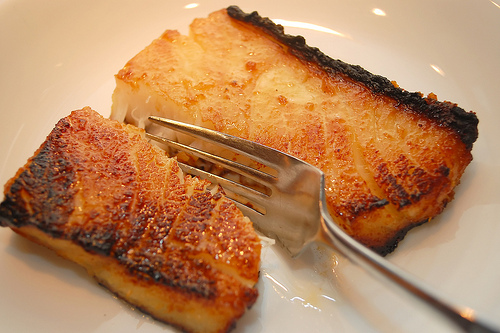 Mmm. That’s great bass. But is it sustainable?Photo: Norm EvangelistaThe international seafood labeling organization, Marine Stewardship Council (MSC) got some boat-rocking news last week, when researchers discovered that a significant portion of what had been labeled MSC-certified Chilean sea bass was in fact something else.
Mmm. That’s great bass. But is it sustainable?Photo: Norm EvangelistaThe international seafood labeling organization, Marine Stewardship Council (MSC) got some boat-rocking news last week, when researchers discovered that a significant portion of what had been labeled MSC-certified Chilean sea bass was in fact something else.
Chilean sea bass, also known as Patagonian toothfish, became enormously popular in the last decade because of its flaky texture and light, buttery taste. But pressure on the slow-growing species made it especially vulnerable to overfishing. Today, the fish tops the red “avoid” category on the Monterey Bay Aquarium’s Seafood Watch list. But, as is the case with most high-end seafood, there is a sustainable option; it comes from a fishery located in the remote waters near South Georgia Island off the coast of Argentina, and it received the MSC nod-of-approval in 2006.
In the study, published in Current Biology, Clemson University population geneticist, Peter Marko, and his colleagues collected 36 samples of MSC-certified Chilean sea bass from grocery stores across 10 different states, and tested the fish for genetic markers. Marko says he chose the sea bass from the South Georgia Island fishery because it had already been certified; because original samples from the fishery existed; and because the fish is genetically distinct from other populations of Chilean sea bass due its geographical isolation.
“The question we asked was: Did the sample of [certified] retail fish come from the same population as the sample from the certified fishery?” says Marko. Unfortunately for consumers who rely on the MSC label to help them navigate the increasingly complex waters of sustainable sourcing, the answer was no.
Of the original 36 samples collected, three turned out to be other species: tuna, mackerel, and greenling. Of the 33 remaining fillets confirmed to be Chilean sea bass, five had genetic markers that suggested they came from somewhere other than the South Georgia Island fishery.
MSC reacted to the news quickly; deputy standards director, Amy Jackson, issued a statement expressing concern over the report, and a pledging to conduct an investigation.
“We carry out regular DNA testing, done [by an independent third party],” Simon Edwards, MSC spokesman told Grist. “This is the first time it has ever come up negative. It took us by surprise and it’s not welcomed news, but what we have in place is an audit trail that will let us remedy what’s gone wrong.”
Edwards says he’s not outright disputing the data, and is careful not to toss around the term “seafood fraud.” He says DNA degradation or poor results can occur, and that testing should be done through certified labs with controlled systems to see if they can duplicate the results. “We need to find out what happened,” he says.
Dr. Michael Hirshfield, chief scientist at Oceana says substitution in seafood is something that goes back for centuries, and that news of mislabeling rarely surprises him. “Any time consumers are buying fish, they’re at risk for having a substitute, especially when it’s something expensive,” he says. Besides, he adds, “People have been skeptical for awhile about how it was possible that so much Chilean sea bass could have been certified by the MSC.”
Concerns of mislabeling and fraud has been an ongoing issue within the seafood industry. In May, Oceana released their own report on seafood fraud: “Bait and Switch: How Seafood Fraud Hurts Our Oceans, Our Wallets and Our Health.” They found that seafood is mislabeled as often as 25-70 percent of the time, especially for species like red snapper, wild salmon, and Atlantic cod.
On the other hand, detection of seafood mislabeling and fraud is gaining traction. Advances in traceability from boat, through processing and distribution, are advancing, and the U.S. government seems to be paying closer attention as well. The FDA is currently creating a DNA database for fish, and will compare those samples to an existing database known as the Fish Barcode of Life.
Consumer guides also carry warnings for eaters. A peek at the Monterey Bay Aquarium’s Seafood Watch’s listing for Chilean sea bass says:
Consumers wishing to purchase MSC-certified Chilean sea bass must be very careful. All restaurants and grocery stores that sell MSC products are required to have the MSC “Chain of Custody” certification. Legitimate purveyors should be able to produce this document when consumers ask. If the certificate is not available, assume the fish is not certified and don’t make the purchase.
But that warning was not intended to be a fraud alert, says Allison Barratt of the Monterey Bay Aquarium. “Our intent was more to try to alert consumers to the fact that very little of the overall catch is certified to the standards of the MSC and most of the Chilean sea bass you see is to still to be avoided,” writes Barratt in an email. “It’s always tricky, messaging-wise, when there’s a segment of any fishery that’s a better choice than the rest of it.”
Whole Foods, which has been carrying the MSC-certified Chilean sea bass, reacted to the news with this statement from Carrie Brownstein, global seafood quality standards coordinator:
Whole Foods Market sources Chilean sea bass (Patagonian toothfish) only from MSC-certified fisheries and can trace all shipments back to the fishing vessel that caught it via a lot code on its shipping box. In addition, Whole Foods Market purchases the fish only partly processed (headed and gutted) so that buyers can see that the fish sourced is actually Patagonian toothfish, which eliminates the risk of other species being substituted.
For consumers who care about sustainable seafood, news of mislabeling or fraud, especially for products that carry certification is frustrating.
“It’s a big issue,” says Ken Peterson, spokesman for the Monterey Bay Aquarium, who believes the MSC is still trustworthy.
“The process they’ve committed to is supposed to ensure chain of custody, from the minute the fish comes out of the water to [the minute] you buy it. They’re the most aggressive in analyzing the steps of the process to see if something breaks down.” If it does, he says, “that’s a much bigger problem than Chilean sea bass.”



